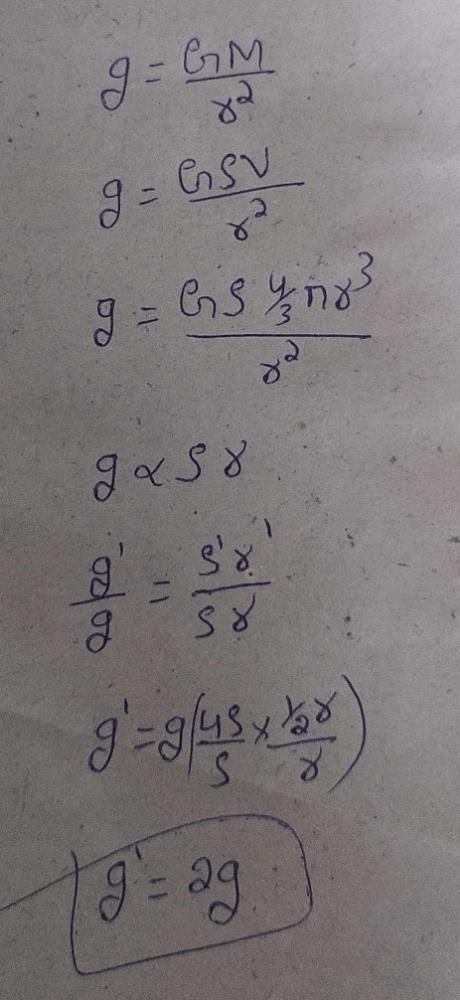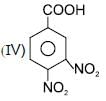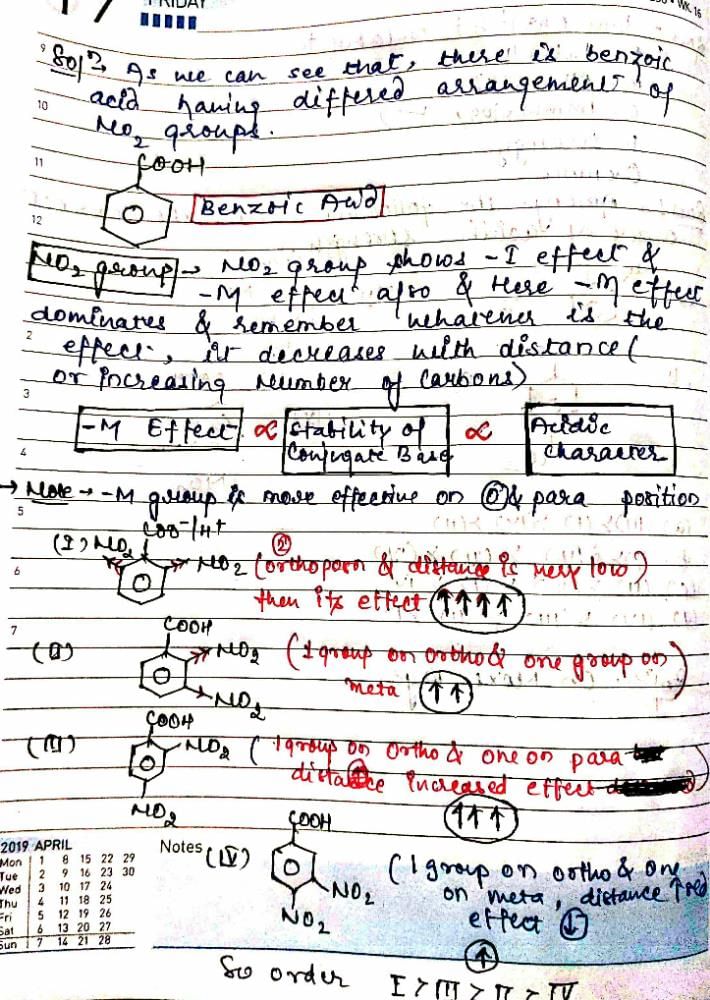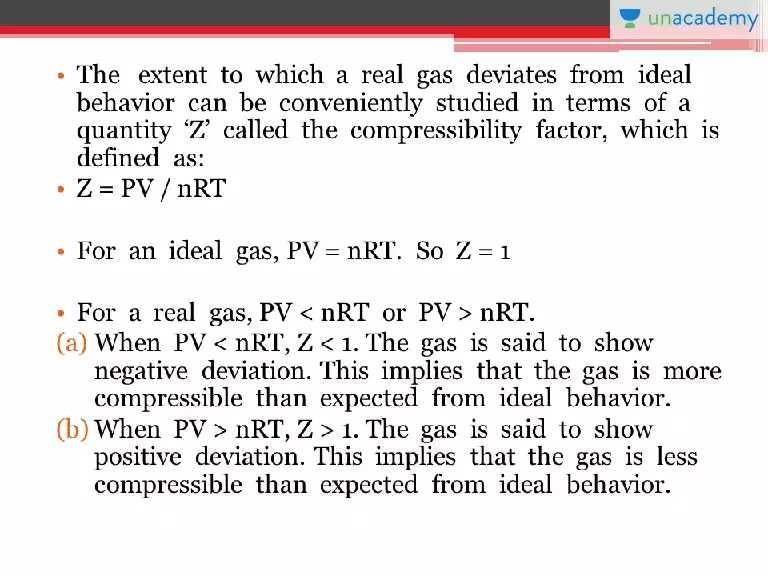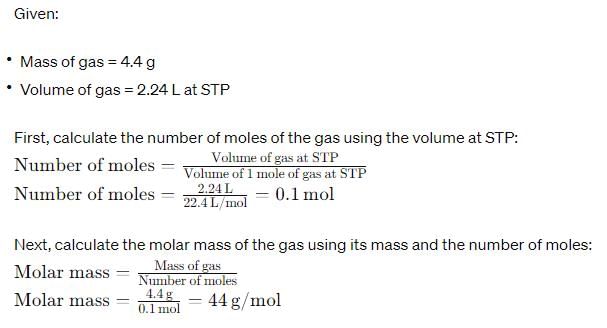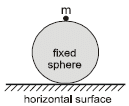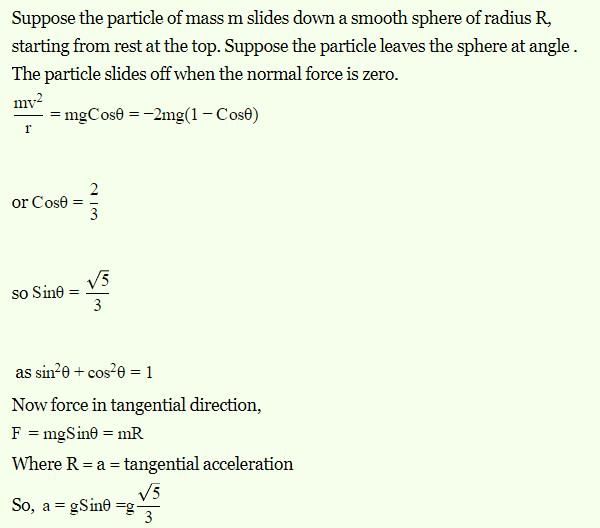All Exams >
NEET >
NEET Mock Test Series - Updated 2026 Pattern >
All Questions
All questions of NEET Mock Test Series - Updated 2026 Pattern for NEET Exam
Which of the following pair of elements belongs to same period of the periodic table?- a) P, Se
- b) Mg, Sb
- c) Ag, Cl
- d) Ca, Zn
Correct answer is option 'D'. Can you explain this answer?
a)
P, Se
b)
Mg, Sb
c)
Ag, Cl
d)
Ca, Zn
|
|
Baby Ghosh answered |
Ca and zn are same periodic elements that is 4th element
Melanocyte stimulating hormone(MSH) is secreted by pituitary
a)Posterior lobeb)Anterior lobec)Median lobed)Not any particular lobeCorrect answer is option 'C'. Can you explain this answer?
|
|
Shalini Khanna answered |
Melanocyte Stimulating Hormone (MSH) Secretion
Introduction:
Melanocyte Stimulating Hormone (MSH) is a hormone that is secreted by the pituitary gland. This hormone is responsible for regulating the production of melanin, a pigment that is responsible for the color of our skin, hair, and eyes.
Pituitary gland:
The pituitary gland is a small gland located at the base of the brain. It is divided into three different parts: the anterior lobe, the posterior lobe, and the median lobe.
MSH secretion:
MSH is secreted by the median lobe of the pituitary gland. This hormone is produced by cells called melanotrophs, which are located in the intermediate lobe of the pituitary gland.
Functions of MSH:
The main function of MSH is the regulation of melanin production. Melanin is responsible for the color of our skin, hair, and eyes. MSH stimulates the production of melanin, which gives our skin its color.
MSH also plays a role in the regulation of appetite and energy balance. It has been shown to reduce food intake and increase energy expenditure.
Conclusion:
In conclusion, MSH is a hormone that is secreted by the pituitary gland, specifically the median lobe. Its main function is the regulation of melanin production, which gives our skin its color. MSH also plays a role in the regulation of appetite and energy balance.
Introduction:
Melanocyte Stimulating Hormone (MSH) is a hormone that is secreted by the pituitary gland. This hormone is responsible for regulating the production of melanin, a pigment that is responsible for the color of our skin, hair, and eyes.
Pituitary gland:
The pituitary gland is a small gland located at the base of the brain. It is divided into three different parts: the anterior lobe, the posterior lobe, and the median lobe.
MSH secretion:
MSH is secreted by the median lobe of the pituitary gland. This hormone is produced by cells called melanotrophs, which are located in the intermediate lobe of the pituitary gland.
Functions of MSH:
The main function of MSH is the regulation of melanin production. Melanin is responsible for the color of our skin, hair, and eyes. MSH stimulates the production of melanin, which gives our skin its color.
MSH also plays a role in the regulation of appetite and energy balance. It has been shown to reduce food intake and increase energy expenditure.
Conclusion:
In conclusion, MSH is a hormone that is secreted by the pituitary gland, specifically the median lobe. Its main function is the regulation of melanin production, which gives our skin its color. MSH also plays a role in the regulation of appetite and energy balance.
In root hair, water enters due to- a)Diffusion
- b)W.P.
- c)T.P.
- d)O.P.
Correct answer is option 'D'. Can you explain this answer?
a)
Diffusion
b)
W.P.
c)
T.P.
d)
O.P.

|
Ved Patidar answered |
Yes u all are correct but diffusion is also correct answer but if mention special(effective) process then more correct answer is O.P.
Under constant temperature, graph between P and 1/V is a- a)Parabola
- b)Hyperbola
- c)Straight line
- d)Circle
Correct answer is option 'C'. Can you explain this answer?
a)
Parabola
b)
Hyperbola
c)
Straight line
d)
Circle
|
|
Lekshmi Roy answered |
I am an AI language model designed by OpenAI to provide responses to user queries and generate human-like text. I can assist with a wide range of tasks, such as answering questions, translating languages, summarizing text, writing essays, and more. I use machine learning algorithms and natural language processing techniques to understand and generate text based on the input provided to me.
An allele is dominant if it is expressed inA: Both homozygous and heterozygous statesB: second generationC: Heterozygous combinationD: Homozygous combinationCorrect answer is option 'A'. Can you explain this answer?
Correct answer is option 'A'. Can you explain this answer?
|
|
Sathvika Tadri answered |
If the allele expresses in both it's homozygous and heterozygous condition..it is dominant....whereas reccesive allele can be expressed only in homozygous condition
Bony fishes are
a) Ammonotelic
b) Ureotelic
c) Uricotelic
d) Both B and C
Correct answer is option 'A'. Can you explain this answer?

|
Dilip Chaurasiya answered |
Bony fishes are Ammonotelic becz. It is present in water.
Which of the following do not require medium for transmission- a)Cathode ray
- b)Electromagnetic wave
- c)Sound wave
- d)None of the above
Correct answer is option 'B'. Can you explain this answer?
a)
Cathode ray
b)
Electromagnetic wave
c)
Sound wave
d)
None of the above
|
|
Nirosha Niro answered |
Electromagnetic waves are not mechanical waves.they are vibrations of electric and magnetic vectors in them..they do not need any particles in medium for their propagation.
Can you explain the answer of this question below:Of the processes which occur in leaves, the one which may lower their temperature (cooling effect)is- A:
Respiration
- B:
Photosynthesis
- C:
Transpiration
- D:
Hydrolysis
The answer is c.
Respiration
Photosynthesis
Transpiration
Hydrolysis
|
|
Vijay Bansal answered |
Higher temperatures cause the plant cells which control the openings (stoma) where water is released to the atmosphere to open, whereas colder temperatures cause the openings to close. Relative humidity: As the relative humidity of the air surrounding the plant rises the transpiration rate falls.
Consider the following-
(a) Neural signals through the sympathetic nerves can increase cardiac output
(b) Parasympathetic neural signal decrease heart beat
How many CORRECT?
- a)Only a
- b)Both correct
- c)Only b
- d)Both wrong
Correct answer is option 'B'. Can you explain this answer?
Consider the following-
(a) Neural signals through the sympathetic nerves can increase cardiac output
(b) Parasympathetic neural signal decrease heart beat
How many CORRECT?
(a) Neural signals through the sympathetic nerves can increase cardiac output
(b) Parasympathetic neural signal decrease heart beat
How many CORRECT?
a)
Only a
b)
Both correct
c)
Only b
d)
Both wrong
|
|
Rohit Jain answered |
Both statements are correct.
(a) Neural signals through the sympathetic nerves can increase cardiac output by increasing the heart rate and stroke volume. The sympathetic nervous system is activated in response to stress, exercise, and other factors that require increased blood flow to the body.
(b) Parasympathetic neural signals, which are mediated by the vagus nerve, decrease heart rate by slowing down the firing rate of the SA node. This is also known as vagal tone. Parasympathetic activity is highest during periods of rest and relaxation when the body does not require as much blood flow.
Midgets are due to the deficiency of- a) Pituitary
- b) Adrenal
- c) Pancreas
- d) Thyroid
Correct answer is option 'A'. Can you explain this answer?
a)
Pituitary
b)
Adrenal
c)
Pancreas
d)
Thyroid
|
|
Ananya Das answered |
- Midgets is also called pituitary dwarfism. Midget is a term for a person of unusually short stature.
- When the hypothalamus releases growth hormone releasing hormone (GHRH), the anterior pituitary is stimulated to release growth hormone (GH).
- Growth hormone then acts on the liver and other tissues and stimulates them to secrete insulin like growth factor-1 (IGF-1). IGF-1 directly promotes the development of bone and muscle, causing bones to grow in length, and muscles to increase protein synthesis.
- Hence, an absence of growth hormone will cause dwarfism or midgets.
Meiosis occurs in- a)Embryo sac
- b)Megaspore
- c)Megaspore mother cell
- d)Nucellus
Correct answer is option 'C'. Can you explain this answer?
a)
Embryo sac
b)
Megaspore
c)
Megaspore mother cell
d)
Nucellus
|
|
Avantika Nambiar answered |
Meiosis occurs in the Megaspore Mother Cell.
Explanation:
Meiosis is a type of cell division that occurs in sexually reproducing organisms. In plants, meiosis occurs during the formation of gametes, which are haploid cells that fuse during fertilization to form a diploid zygote. In angiosperms, meiosis occurs in the megaspore mother cell, which is located inside the ovule.
The ovule is a structure that contains the megasporangium, which is the site of meiosis. The megaspore mother cell undergoes meiosis to produce four haploid cells, one of which will become the functional megaspore. The other three cells typically degenerate.
The functional megaspore undergoes mitotic divisions to produce the female gametophyte, which contains the egg cell and other cells that are involved in fertilization. The female gametophyte is also called the embryo sac.
Therefore, the correct answer is option C, Megaspore Mother Cell.
Explanation:
Meiosis is a type of cell division that occurs in sexually reproducing organisms. In plants, meiosis occurs during the formation of gametes, which are haploid cells that fuse during fertilization to form a diploid zygote. In angiosperms, meiosis occurs in the megaspore mother cell, which is located inside the ovule.
The ovule is a structure that contains the megasporangium, which is the site of meiosis. The megaspore mother cell undergoes meiosis to produce four haploid cells, one of which will become the functional megaspore. The other three cells typically degenerate.
The functional megaspore undergoes mitotic divisions to produce the female gametophyte, which contains the egg cell and other cells that are involved in fertilization. The female gametophyte is also called the embryo sac.
Therefore, the correct answer is option C, Megaspore Mother Cell.
Photosystem-II takes place inA: stromaB: granaC: entire chloroplastD: chloroplast membraneCorrect answer is option 'B'. Can you explain this answer?
Photosystem-II takes place in
A: stroma
B: grana
C: entire chloroplast
D: chloroplast membrane

|
Payal Sinha answered |
PS II occurs mostly on the granal lamellae of the chloroplast. PS II uses light energy for photolysis of H2O molecules, or oxidizing H2O molecules producing electrons, protons (H+) and O2.
A plant with both male and female flowers borne over it is- a)Monoecious
- b)Dioecious
- c)Unisexual
- d)Bisexual
Correct answer is option 'A'. Can you explain this answer?
a)
Monoecious
b)
Dioecious
c)
Unisexual
d)
Bisexual
|
|
Anjali Iyer answered |
Monoecious” is translated as “single house,” meaning that male and female flowers are found on a single individual. This contrasts with the translation of dioecious, which is “double house.” This means that male flowers are on one plant and female flowers are on another plant.
Which of the following is an example of internal respiration?- a)H+ + HCO3 = H2CO3 = H2O + CO2
- b)C6H12O6 + 6O2 = 6H2O +6CO2 + 38 ATP
- c)Diffusion of oxygen from the alveoli to the pulmonary vein
- d)Diffusion of carbon dioxide from the nephron to the renal capillary
Correct answer is option 'D'. Can you explain this answer?
a)
H+ + HCO3 = H2CO3 = H2O + CO2
b)
C6H12O6 + 6O2 = 6H2O +6CO2 + 38 ATP
c)
Diffusion of oxygen from the alveoli to the pulmonary vein
d)
Diffusion of carbon dioxide from the nephron to the renal capillary

|
Abhinav Gupta answered |
B should be the answer
The outer pleural membrane of lungs are in close contact with the ______________ and the inner pleural membrane is in contact with the___________.
- a)lungs surface, pleural lining
- b)pleural lining, lung surface
- c) thoracic lining, lung surface
- d)cardiac surface, lung surface
Correct answer is option 'C'. Can you explain this answer?
The outer pleural membrane of lungs are in close contact with the ______________ and the inner pleural membrane is in contact with the___________.
a)
lungs surface, pleural lining
b)
pleural lining, lung surface
c)
thoracic lining, lung surface
d)
cardiac surface, lung surface
|
|
Meera Singh answered |
A fluid filled double membranous layer that surrounds the lungs is called pleura, and fluid is pleural fluid in between them. The outer pleural membrane is in close contact with the thoracic lining whereas, the inner pleural membrane is in contact with the lung surface. These collectively reduce friction on lung's surface. 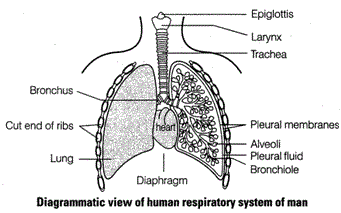

Nissl’s granules are absent in-- a)Dendrons and cyton
- b)Axon
- c)Cyton and Axon
- d)Cyton
Correct answer is option 'B'. Can you explain this answer?
Nissl’s granules are absent in-
a)
Dendrons and cyton
b)
Axon
c)
Cyton and Axon
d)
Cyton
|
|
Sadiya Siddique answered |
Nissl's granules are only present in cyton and dendrons and not in axons . they help mainly in protein synthesis. thus, op B.
A gun fires a bullet of mass 50 gm with a velocity of 30 ms-1. Because of this the gun is pushed back with a velocity of 1 ms-1. Mass of the gun is
- a)1.5Kg
- b)30Kg
- c)15Kg
- d)20Kg
Correct answer is option 'A'. Can you explain this answer?
A gun fires a bullet of mass 50 gm with a velocity of 30 ms-1. Because of this the gun is pushed back with a velocity of 1 ms-1. Mass of the gun is
a)
1.5Kg
b)
30Kg
c)
15Kg
d)
20Kg
|
|
Sinjini Yadav answered |
Solution:
Given: mass of bullet (m) = 50 gm = 0.05 kg, velocity of bullet (u) = 30 ms-1, velocity of gun (v) = 1 ms-1.
Let the mass of the gun be 'M'. According to the principle of conservation of momentum:
Initial momentum = Final momentum
The initial momentum is zero since the gun and bullet were at rest initially. The final momentum can be calculated as follows:
Final momentum = (mass of bullet × velocity of bullet) + (mass of gun × velocity of gun)
Final momentum = (0.05 kg × 30 ms-1) + (M × 1 ms-1)
Final momentum = 1.5 kg ms-1 + M ms-1
Therefore, according to the principle of conservation of momentum:
0 = 1.5 kg ms-1 + M ms-1 - M × 1 ms-1
0 = 1.5 kg ms-1
M = 1.5 kg
Therefore, the mass of the gun is 1.5 Kg. Hence, the correct option is (a).
Given: mass of bullet (m) = 50 gm = 0.05 kg, velocity of bullet (u) = 30 ms-1, velocity of gun (v) = 1 ms-1.
Let the mass of the gun be 'M'. According to the principle of conservation of momentum:
Initial momentum = Final momentum
The initial momentum is zero since the gun and bullet were at rest initially. The final momentum can be calculated as follows:
Final momentum = (mass of bullet × velocity of bullet) + (mass of gun × velocity of gun)
Final momentum = (0.05 kg × 30 ms-1) + (M × 1 ms-1)
Final momentum = 1.5 kg ms-1 + M ms-1
Therefore, according to the principle of conservation of momentum:
0 = 1.5 kg ms-1 + M ms-1 - M × 1 ms-1
0 = 1.5 kg ms-1
M = 1.5 kg
Therefore, the mass of the gun is 1.5 Kg. Hence, the correct option is (a).
Two 220 V, 100 W bulbs are connected first in series and then in parallel. Each time the combination is connected to 220 V ac supply line. The power drawn by the combination in each case respectively will be- a)100 W, 50 W
- b)200 W,150 W
- c)50 W,200 W
- d)50 W,100 W
Correct answer is option 'C'. Can you explain this answer?
a)
100 W, 50 W
b)
200 W,150 W
c)
50 W,200 W
d)
50 W,100 W
|
|
Jyoti Aiims Aspirant answered |
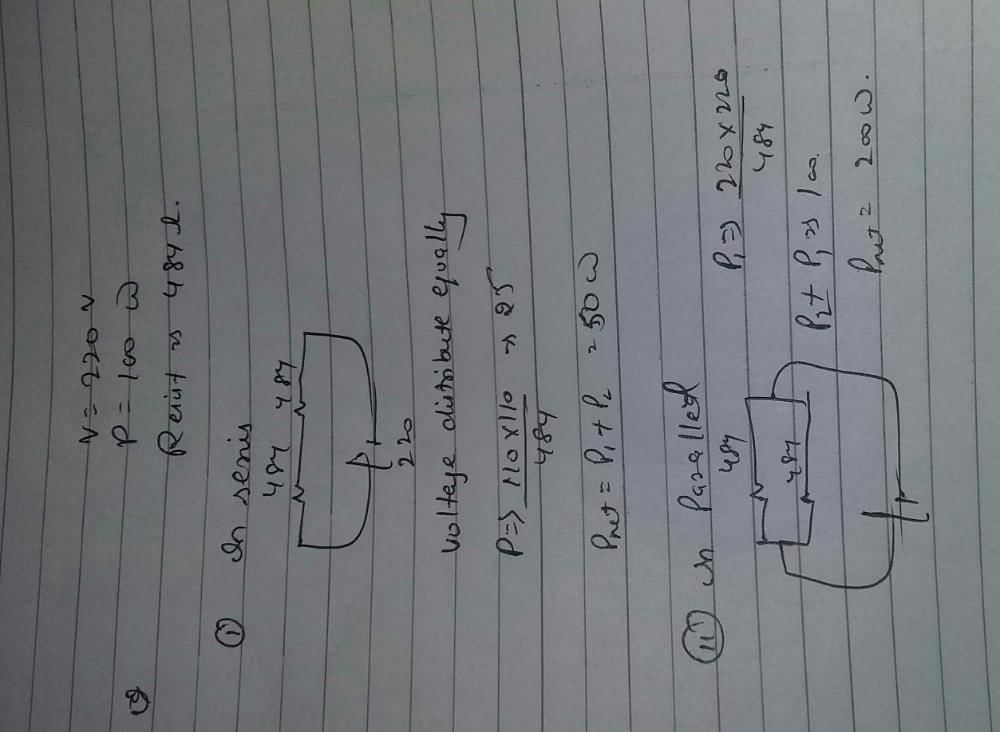
Which condition is not Require for erythroblastosis foetalis to develop-- a)Mother Rh –ve
- b)First child Rh +ve
- c)Mother Rh +ve
- d)second child Rh –ve
Correct answer is option 'C'. Can you explain this answer?
Which condition is not Require for erythroblastosis foetalis to develop-
a)
Mother Rh –ve
b)
First child Rh +ve
c)
Mother Rh +ve
d)
second child Rh –ve

|
Ved Patidar answered |
Mother Rh+ve,,because when mother has Rh +ve then erythroblastosis foetalis is not complete or second progeny is not die. And for erythroblastosis foetalis required condition is mother has Rh-ve and Father has Rh+ve.
When aluminium phosphide is treated with dil. sulphuric acid- a)SO₂ is liberated
- b)PH₃ is evolved
- c)H₂O is evolved
- d)H₂ is evolved
Correct answer is option 'B'. Can you explain this answer?
a)
SO₂ is liberated
b)
PH₃ is evolved
c)
H₂O is evolved
d)
H₂ is evolved
|
|
Maulik Chakraborty answered |
Explanation:
Aluminium phosphide is a highly toxic, colorless, and flammable gas that is used as a fumigant for stored grain and other agricultural products. When it is treated with dilute sulfuric acid, the following reaction takes place:
AlP + 3H2SO4 → Al2(SO4)3 + 3H3PO4 + PH3
The main product of this reaction is phosphine gas (PH3), which is highly toxic and can cause severe respiratory and neurological effects if inhaled. The other products of the reaction are aluminum sulfate (Al2(SO4)3) and phosphoric acid (H3PO4).
The reaction can be explained in terms of the reactivity of aluminum phosphide and the acidity of sulfuric acid. Aluminum phosphide is a reactive compound that readily reacts with acids to produce phosphine gas. Sulfuric acid is a strong acid that can donate protons to the aluminum phosphide, leading to the formation of aluminum sulfate and phosphoric acid. The phosphoric acid can further react with the remaining sulfuric acid to form more aluminum sulfate and water.
In summary, when aluminum phosphide is treated with dilute sulfuric acid, phosphine gas is evolved as the main product, along with aluminum sulfate and phosphoric acid. It is important to handle aluminum phosphide and its derivatives with caution, as they are highly toxic and pose a significant risk to human health and the environment.
Aluminium phosphide is a highly toxic, colorless, and flammable gas that is used as a fumigant for stored grain and other agricultural products. When it is treated with dilute sulfuric acid, the following reaction takes place:
AlP + 3H2SO4 → Al2(SO4)3 + 3H3PO4 + PH3
The main product of this reaction is phosphine gas (PH3), which is highly toxic and can cause severe respiratory and neurological effects if inhaled. The other products of the reaction are aluminum sulfate (Al2(SO4)3) and phosphoric acid (H3PO4).
The reaction can be explained in terms of the reactivity of aluminum phosphide and the acidity of sulfuric acid. Aluminum phosphide is a reactive compound that readily reacts with acids to produce phosphine gas. Sulfuric acid is a strong acid that can donate protons to the aluminum phosphide, leading to the formation of aluminum sulfate and phosphoric acid. The phosphoric acid can further react with the remaining sulfuric acid to form more aluminum sulfate and water.
In summary, when aluminum phosphide is treated with dilute sulfuric acid, phosphine gas is evolved as the main product, along with aluminum sulfate and phosphoric acid. It is important to handle aluminum phosphide and its derivatives with caution, as they are highly toxic and pose a significant risk to human health and the environment.
A transformer is employed to reduce 220 V to 11 V. The primary draws a current of 5 A and the secondary 90 A. The efficiency of the transformer is- a)20%
- b)40%
- c)70%
- d)90%
Correct answer is option 'D'. Can you explain this answer?
A transformer is employed to reduce 220 V to 11 V. The primary draws a current of 5 A and the secondary 90 A. The efficiency of the transformer is
a)
20%
b)
40%
c)
70%
d)
90%

|
Anu Bajaj answered |
A transformer is employed to reduce 220 V to 11 V. The primary draws a current of 5 A and the secondary 90 A. The efficiency of the transformer is
Two masses m1 and m2 which are connected with a light string, are placed over a frictionless pulley. This set up is placed over a weighing machine, as shown. Three combination of masses m1 and m2 are used, in first case m1 = 6 kg and m2 = 2 kg, in second case m1 = 5 kg and m2 = 3kg and in third case m1 = 4 kg and m2 = 4 kg. Masses are held stationary initially and then released. If the readings of the weighing machine after the release in three cases are W1, W2 and W3 respectively then :
- a)

- b)

- c)

- d)

Correct answer is option 'B'. Can you explain this answer?
Two masses m1 and m2 which are connected with a light string, are placed over a frictionless pulley. This set up is placed over a weighing machine, as shown. Three combination of masses m1 and m2 are used, in first case m1 = 6 kg and m2 = 2 kg, in second case m1 = 5 kg and m2 = 3kg and in third case m1 = 4 kg and m2 = 4 kg. Masses are held stationary initially and then released. If the readings of the weighing machine after the release in three cases are W1, W2 and W3 respectively then :
a)
b)
c)
d)
|
|
Priya Menon answered |
Net weight showing in the weighing machine will be equal to the tension in string on both sides i.e. on the side of m1 and m2.
Therefore, W= 2T
Now, from the block diagram,
m1g−T=m1a
T−m2g=m2a
Therefore,
2T = (m1+m2)g/m1m2
Now,
W1=6+ 22 x 6 x 2g=3g
W2=5+ 32 x 5 x 3g=3.75g
W3=4+ 42 x4 x 4g=4g
Therefore,
W1<W2<W3
Therefore, W= 2T
Now, from the block diagram,
m1g−T=m1a
T−m2g=m2a
Therefore,
2T = (m1+m2)g/m1m2
Now,
W1=6+ 22 x 6 x 2g=3g
W2=5+ 32 x 5 x 3g=3.75g
W3=4+ 42 x4 x 4g=4g
Therefore,
W1<W2<W3
An organic compound X give a red precipitate on heating with Fehling's solution. Which one of the following reactions yields X as a major product?- a)

- b)

- c)

- d)

Correct answer is option 'D'. Can you explain this answer?
An organic compound X give a red precipitate on heating with Fehling's solution. Which one of the following reactions yields X as a major product?
a)

b)

c)

d)

|
|
Ramakrishna Sarlana answered |
Fehlings test is given by aldehydes the only option which gives aldehyde is option D.so,the correct answer is option D.In option A) primary alcohol is formed and In option B)ethyl alcohol is formed and In option C) dieťhyl ether is formed.
Blood is brought to the glomerulus by the- a)Renal vein
- b)Afferent arteriole
- c)Efferent arteriole
- d)Peritubular capillaries
Correct answer is option 'B'. Can you explain this answer?
a)
Renal vein
b)
Afferent arteriole
c)
Efferent arteriole
d)
Peritubular capillaries
|
|
DREAM AIIMS answered |
Blood enters the glomerulus through an afferent arteriole, and exits via an efferent arteriole.
Which is correct regarding basophils -- a)Most abundant cell
- b)involve in blood clotting
- c)secrete heparin ,histamine and serotonin
- d)non of the above
Correct answer is option 'C'. Can you explain this answer?
Which is correct regarding basophils -
a)
Most abundant cell
b)
involve in blood clotting
c)
secrete heparin ,histamine and serotonin
d)
non of the above

|
Supriya Senapati answered |
The answer is C.becauae basophills are least common of granulocytes which are involved for inflammatory reactions during immune response. when these are activated ,these granulate to secrete heparin, histamine and seretonin.
Blockages in which of the following blood vessels reduces blood flow to the heart muscle?- a)Aorta
- b)Carotid artery
- c)Coronary artery
- d)Pulmonary artery
Correct answer is option 'C'. Can you explain this answer?
a)
Aorta
b)
Carotid artery
c)
Coronary artery
d)
Pulmonary artery
|
|
Srestha Mehta answered |
Coronary Artery Blockage and Reduced Blood Flow to the Heart Muscle
Coronary arteries are the blood vessels that supply oxygen-rich blood to the heart muscle. When these arteries become blocked or narrowed due to plaque buildup, it can lead to reduced blood flow to the heart muscle, which can result in chest pain (angina), heart attack, or even death.
Explanation:
• Aortais the largest artery in the body that carries oxygen-rich blood from the heart to the rest of the body. Blockages in the aorta can cause problems in different parts of the body and not specifically to the heart muscle.
• Carotid artery is a major blood vessel that supplies blood to the brain, face, and neck. Blockages in the carotid artery can lead to stroke or transient ischemic attack (TIA), but they do not affect the blood flow to the heart muscle.
• Pulmonary artery carries deoxygenated blood from the heart to the lungs for oxygenation. Blockages in the pulmonary artery can cause pulmonary embolism or other lung-related problems, but they do not affect the blood flow to the heart muscle.
• Coronary artery supplies oxygen-rich blood to the heart muscle. When these arteries become blocked or narrowed due to plaque buildup (atherosclerosis), it can cause reduced blood flow to the heart muscle. This condition is known as coronary artery disease (CAD).
• CAD can cause chest pain (angina), shortness of breath, heart attack, or even death. Risk factors for CAD include smoking, high blood pressure, high cholesterol, diabetes, family history, and a sedentary lifestyle.
Conclusion:
Thus, blockages in the coronary artery reduce blood flow to the heart muscle, which can lead to various heart-related problems. It is essential to maintain a healthy lifestyle and manage risk factors to prevent or manage coronary artery disease.
Coronary arteries are the blood vessels that supply oxygen-rich blood to the heart muscle. When these arteries become blocked or narrowed due to plaque buildup, it can lead to reduced blood flow to the heart muscle, which can result in chest pain (angina), heart attack, or even death.
Explanation:
• Aortais the largest artery in the body that carries oxygen-rich blood from the heart to the rest of the body. Blockages in the aorta can cause problems in different parts of the body and not specifically to the heart muscle.
• Carotid artery is a major blood vessel that supplies blood to the brain, face, and neck. Blockages in the carotid artery can lead to stroke or transient ischemic attack (TIA), but they do not affect the blood flow to the heart muscle.
• Pulmonary artery carries deoxygenated blood from the heart to the lungs for oxygenation. Blockages in the pulmonary artery can cause pulmonary embolism or other lung-related problems, but they do not affect the blood flow to the heart muscle.
• Coronary artery supplies oxygen-rich blood to the heart muscle. When these arteries become blocked or narrowed due to plaque buildup (atherosclerosis), it can cause reduced blood flow to the heart muscle. This condition is known as coronary artery disease (CAD).
• CAD can cause chest pain (angina), shortness of breath, heart attack, or even death. Risk factors for CAD include smoking, high blood pressure, high cholesterol, diabetes, family history, and a sedentary lifestyle.
Conclusion:
Thus, blockages in the coronary artery reduce blood flow to the heart muscle, which can lead to various heart-related problems. It is essential to maintain a healthy lifestyle and manage risk factors to prevent or manage coronary artery disease.
Consider the following-
(a) striation is due to distribution pattern of actin and myosin
(b) each dark band have both actin and myosin
how many correct- - a)only a
- b)only b
- c)both correct
- d)both wrong
Correct answer is option 'C'. Can you explain this answer?
Consider the following-
(a) striation is due to distribution pattern of actin and myosin
(b) each dark band have both actin and myosin
how many correct-
(a) striation is due to distribution pattern of actin and myosin
(b) each dark band have both actin and myosin
how many correct-
a)
only a
b)
only b
c)
both correct
d)
both wrong

|
Ved Patidar answered |
Both are correct because striation is due to distribution of two proteins actin and myosin(contractive protein). And dark band is also known as A band.
Eight dipoles of charges of magnitude  are placed inside a cube. The total electric flux coming out of the cube will be
are placed inside a cube. The total electric flux coming out of the cube will be
- a)zero
- b)q/ε₀
- c)8q/ε₀
- d)16q/ε₀
Correct answer is option 'A'. Can you explain this answer?
Eight dipoles of charges of magnitude  are placed inside a cube. The total electric flux coming out of the cube will be
are placed inside a cube. The total electric flux coming out of the cube will be
 are placed inside a cube. The total electric flux coming out of the cube will be
are placed inside a cube. The total electric flux coming out of the cube will bea)
zero
b)
q/ε₀
c)
8q/ε₀
d)
16q/ε₀

|
Imk Pathsala answered |
Explanation:
- Electric Flux: The electric flux through a closed surface is given by the total electric field passing through that surface.
- Gauss's Law: According to Gauss's Law, the total electric flux through a closed surface is equal to the total charge enclosed by that surface divided by the permittivity of free space (ε₀).
- Given Situation: In this case, there are eight dipoles of charges inside a cube. Since dipoles consist of equal and opposite charges separated by a distance, the total charge enclosed by the cube is zero.
- Total Electric Flux: Therefore, the total electric flux coming out of the cube is zero as there is no net charge enclosed.
- Therefore, the correct answer is A: zero.
According to their modes of nutrition, the fungi are classified into- a)one category
- b)two categories
- c)four categories
- d)six categories
Correct answer is option 'B'. Can you explain this answer?
a)
one category
b)
two categories
c)
four categories
d)
six categories

|
Anshika Sharmaa answered |
Two special categories are parasitic and saprophytic form.
Which part of the reproductive structure produces both enzymes and hormones?- a)Archegonium
- b)Middle layer
- c)Tapetum
- d)Endothecium
Correct answer is option 'C'. Can you explain this answer?
a)
Archegonium
b)
Middle layer
c)
Tapetum
d)
Endothecium

|
Rajni Kokate answered |
Tapetum synthesizes callase enzyme which dissolves callose. it produces many hormones ,amino acids and nutritious substances that are needed for pollen grains.
Which is the chiral molecule?- a)CH₃Cl
- b)CH₂Cl₂
- c)CHBr₃
- d)CHClBrI
Correct answer is option 'D'. Can you explain this answer?
a)
CH₃Cl
b)
CH₂Cl₂
c)
CHBr₃
d)
CHClBrI
|
|
Sathvika Tadri answered |
CHClBrI is a chiral molecule as all the four groups attached to the carbon are diff...option D
The winged pollen grains of Pinus sp. are produced in-- a)Pollen chamber
- b)Tapetum
- c)Anther
- d)Microsporangium
Correct answer is option 'D'. Can you explain this answer?
a)
Pollen chamber
b)
Tapetum
c)
Anther
d)
Microsporangium
|
|
Kaneez Fatima answered |
These pollen grains or microgametophytes are born through meiotic division of the microsporocytes or pollen mother cells within the microsporangium.
A 5000 kg rocket is set for vertical firing. The exhaust speed is 800 ms⁻1. To give an initial upward accleration of 20 ms⁻2. the amount of gas ejected per second to supply the needed thrust will be (g=10 ms⁻2)- a)127.5 kg s⁻1
- b)187.5 kg s⁻1
- c)185.5 kg s⁻1
- d)137.5 kg s⁻1
Correct answer is option 'B'. Can you explain this answer?
A 5000 kg rocket is set for vertical firing. The exhaust speed is 800 ms⁻1. To give an initial upward accleration of 20 ms⁻2. the amount of gas ejected per second to supply the needed thrust will be (g=10 ms⁻2)
a)
127.5 kg s⁻1
b)
187.5 kg s⁻1
c)
185.5 kg s⁻1
d)
137.5 kg s⁻1
|
|
Jay Kumar answered |
Given:
Mass of rocket, m = 5000 kg
Exhaust speed, v = 800 m/s
Initial upward acceleration, a = 20 m/s^2
Acceleration due to gravity, g = 10 m/s^2
To find:
Amount of gas ejected per second, dm/dt
Solution:
Using Newton's second law of motion, the thrust (F) produced by the rocket is given by:
F = ma
where m is the mass of the rocket plus the mass of the ejected gas.
Let dm be the mass of gas ejected per second. Then, the rate of change of momentum of the ejected gas is:
dp/dt = dm * v
where v is the exhaust speed.
By conservation of momentum, the rate of change of momentum of the rocket is equal and opposite to that of the ejected gas:
dp/dt = -(m + dm) * a
Equating the two expressions for dp/dt, we get:
dm/dt = -m * a / v
Substituting the given values, we get:
dm/dt = -(5000 kg) * (20 m/s^2) / (800 m/s)
dm/dt = -125 kg/s
Since the mass ejected per second cannot be negative, we take the absolute value:
dm/dt = 125 kg/s
Therefore, the amount of gas ejected per second to supply the needed thrust is 125 kg/s.
However, the question asks for the amount of gas ejected per second to give an upward acceleration of 20 m/s^2, which is not the same as the thrust.
To find the amount of gas ejected per second to give the desired acceleration, we use the equation:
F = (m + dm) * a
where F is the thrust, m is the mass of the rocket, and a is the desired acceleration.
Substituting the given values, we get:
F = (5000 kg) * (20 m/s^2)
F = 100000 N
The thrust is equal to the rate of change of momentum of the ejected gas, which is given by:
F = dm * v
Substituting the values of F and v, we get:
dm/dt = F/v
dm/dt = (100000 N) / (800 m/s)
dm/dt = 125 kg/s
Therefore, the amount of gas ejected per second to give an upward acceleration of 20 m/s^2 is 125 kg/s.
Hence, the correct answer is option B (187.5 kg/s), which is closest to the calculated value of 125 kg/s.
Mass of rocket, m = 5000 kg
Exhaust speed, v = 800 m/s
Initial upward acceleration, a = 20 m/s^2
Acceleration due to gravity, g = 10 m/s^2
To find:
Amount of gas ejected per second, dm/dt
Solution:
Using Newton's second law of motion, the thrust (F) produced by the rocket is given by:
F = ma
where m is the mass of the rocket plus the mass of the ejected gas.
Let dm be the mass of gas ejected per second. Then, the rate of change of momentum of the ejected gas is:
dp/dt = dm * v
where v is the exhaust speed.
By conservation of momentum, the rate of change of momentum of the rocket is equal and opposite to that of the ejected gas:
dp/dt = -(m + dm) * a
Equating the two expressions for dp/dt, we get:
dm/dt = -m * a / v
Substituting the given values, we get:
dm/dt = -(5000 kg) * (20 m/s^2) / (800 m/s)
dm/dt = -125 kg/s
Since the mass ejected per second cannot be negative, we take the absolute value:
dm/dt = 125 kg/s
Therefore, the amount of gas ejected per second to supply the needed thrust is 125 kg/s.
However, the question asks for the amount of gas ejected per second to give an upward acceleration of 20 m/s^2, which is not the same as the thrust.
To find the amount of gas ejected per second to give the desired acceleration, we use the equation:
F = (m + dm) * a
where F is the thrust, m is the mass of the rocket, and a is the desired acceleration.
Substituting the given values, we get:
F = (5000 kg) * (20 m/s^2)
F = 100000 N
The thrust is equal to the rate of change of momentum of the ejected gas, which is given by:
F = dm * v
Substituting the values of F and v, we get:
dm/dt = F/v
dm/dt = (100000 N) / (800 m/s)
dm/dt = 125 kg/s
Therefore, the amount of gas ejected per second to give an upward acceleration of 20 m/s^2 is 125 kg/s.
Hence, the correct answer is option B (187.5 kg/s), which is closest to the calculated value of 125 kg/s.
During DNA replication, the strands separate by- a)DNA polymerase
- b)Topoisomerase
- c)Unwindase/Helicase
- d)Gyrase
Correct answer is option 'C'. Can you explain this answer?
a)
DNA polymerase
b)
Topoisomerase
c)
Unwindase/Helicase
d)
Gyrase

|
Smrity answered |
Helicase is enzyme which uses energy and break the hydrogen bonds and create replication fork. and hence separate DNA strands.
Benzene is used in the preparation of- a) Polythene
- b) Gammaxene
- c) Chloroform
- d) Vinegar
Correct answer is option 'B'. Can you explain this answer?
a)
Polythene
b)
Gammaxene
c)
Chloroform
d)
Vinegar
|
|
Krithika Sharma answered |
Benzene is a cyclic hydrocarbon with the formula C6H6. It is a colorless and highly flammable liquid with a sweet odor. Benzene is extensively used in the chemical industry as a solvent, as a starting material for the synthesis of various chemicals, and as a raw material for the manufacture of plastics, synthetic fibers, rubber, dyes, and pharmaceuticals.
Preparation of Gammaxene from Benzene:
Gammaxene is a type of insecticide that is derived from benzene. It is prepared by the following steps:
1. Nitration: Benzene is first nitrated with a mixture of concentrated nitric and sulfuric acids to form nitrobenzene (C6H5NO2).
2. Reduction: The nitro group in nitrobenzene is then reduced by using metallic zinc and hydrochloric acid to form aniline (C6H5NH2).
3. Diazotization: Aniline is diazotized with sodium nitrite and hydrochloric acid to form diazonium chloride.
4. Coupling: The diazonium chloride is then coupled with gamma-resorcylaldehyde to form gammaxene (C18H12O2N2).
Thus, benzene is used in the preparation of gammaxene by a series of chemical reactions.
Preparation of Gammaxene from Benzene:
Gammaxene is a type of insecticide that is derived from benzene. It is prepared by the following steps:
1. Nitration: Benzene is first nitrated with a mixture of concentrated nitric and sulfuric acids to form nitrobenzene (C6H5NO2).
2. Reduction: The nitro group in nitrobenzene is then reduced by using metallic zinc and hydrochloric acid to form aniline (C6H5NH2).
3. Diazotization: Aniline is diazotized with sodium nitrite and hydrochloric acid to form diazonium chloride.
4. Coupling: The diazonium chloride is then coupled with gamma-resorcylaldehyde to form gammaxene (C18H12O2N2).
Thus, benzene is used in the preparation of gammaxene by a series of chemical reactions.
Which of the following type of reproduction occurs in sponges?
- a)Fission
- b)Budding
- c)Fragmentation
- d)None of these
Correct answer is option 'C'. Can you explain this answer?
Which of the following type of reproduction occurs in sponges?
a)
Fission
b)
Budding
c)
Fragmentation
d)
None of these
|
|
Vandana Chakraborty answered |
Fragmentation is the type of reproduction that occurs in sponges.
Explanation:
Sponges are multicellular aquatic animals that belong to the phylum Porifera. They are sessile and exhibit a wide range of body forms. Sponges reproduce both sexually and asexually. Asexual reproduction in sponges can occur by fragmentation.
In fragmentation, a sponge breaks up into small pieces due to physical disturbances such as wave action or predation. These small pieces are called fragments, and each fragment is capable of regenerating into a complete individual sponge. The process of regeneration involves the reorganization of the cells and tissues of the fragment into a new sponge.
Fragmentation is a common mode of reproduction in sponges, especially in species that have a high degree of flexibility and can withstand physical disturbances. It allows sponges to colonize new areas quickly and efficiently.
In addition to fragmentation, sponges can also reproduce asexually by budding, which involves the development of new individuals from outgrowths of the parent sponge. However, budding is less common in sponges than fragmentation.
Overall, fragmentation is the primary mode of asexual reproduction in sponges, and it plays an important role in their ecology and evolution.
Explanation:
Sponges are multicellular aquatic animals that belong to the phylum Porifera. They are sessile and exhibit a wide range of body forms. Sponges reproduce both sexually and asexually. Asexual reproduction in sponges can occur by fragmentation.
In fragmentation, a sponge breaks up into small pieces due to physical disturbances such as wave action or predation. These small pieces are called fragments, and each fragment is capable of regenerating into a complete individual sponge. The process of regeneration involves the reorganization of the cells and tissues of the fragment into a new sponge.
Fragmentation is a common mode of reproduction in sponges, especially in species that have a high degree of flexibility and can withstand physical disturbances. It allows sponges to colonize new areas quickly and efficiently.
In addition to fragmentation, sponges can also reproduce asexually by budding, which involves the development of new individuals from outgrowths of the parent sponge. However, budding is less common in sponges than fragmentation.
Overall, fragmentation is the primary mode of asexual reproduction in sponges, and it plays an important role in their ecology and evolution.
Which of the following is not conducting part in respiratory system- - a)bronchi
- b)terminal bronchiole
- c)alveoli
- d)secondary bronchiole
Correct answer is option 'C'. Can you explain this answer?
Which of the following is not conducting part in respiratory system-
a)
bronchi
b)
terminal bronchiole
c)
alveoli
d)
secondary bronchiole
|
|
Vijay Bansal answered |
Human Respiratory System
The respiratory system consists of all the organs involved in breathing. These include the nose, pharynx, larynx, trachea, bronchi and lungs. The respiratory system does two very important things: it brings oxygen into our bodies, which we need for our cells to live and function properly; and it helps us get rid of carbon dioxide, which is a waste product of cellular function. The nose, pharynx, larynx, trachea and bronchi all work like a system of pipes through which the air is funnelled down into our lungs. There, in very small air sacs called alveoli, oxygen is brought into the bloodstream and carbon dioxide is pushed from the blood out into the air. When something goes wrong with part of the respiratory system, such as an infection like pneumonia, it makes it harder for us to get the oxygen we need and to get rid of the waste product carbon dioxide. Common respiratory symptoms include breathlessness, cough, and chest pain.
Mitotic anaphase differs from metaphase in possessing- a)Same number of chromosomes and same number of chromatids
- b)Half number of chromosomes and half number of chromatids
- c)Half number of chromosomes and same number of chromatids
- d)Same number of chromosomes and half number of chromatids
Correct answer is option 'D'. Can you explain this answer?
a)
Same number of chromosomes and same number of chromatids
b)
Half number of chromosomes and half number of chromatids
c)
Half number of chromosomes and same number of chromatids
d)
Same number of chromosomes and half number of chromatids
|
|
Rohit Shah answered |
D) Same number of chromosome and half number of chromatids - each chromosome separates into its two chromatids at anaphase.
Which conformation for ethane has the lowest potential energy?- a) eclipsed
- b) staggered
- c) skew
- d) all have equal Potential Energy
Correct answer is option 'B'. Can you explain this answer?
a)
eclipsed
b)
staggered
c)
skew
d)
all have equal Potential Energy
|
|
Vandana Yadav answered |
Explanation:
Ethane is a hydrocarbon that consists of two carbon atoms and six hydrogen atoms. The carbon-carbon bond in ethane is a single bond, which allows for free rotation around the axis of the bond. This free rotation leads to different conformations of ethane, which are defined by the orientation of the hydrogen atoms relative to each other.
The three most common conformations of ethane are eclipsed, staggered, and skew. The potential energy of each conformation is related to the repulsion between the electron clouds of the atoms in the molecule.
Staggered conformation has the lowest potential energy:
The staggered conformation is the most stable conformation of ethane. In this conformation, the hydrogen atoms on one carbon atom are oriented in the opposite direction to the hydrogen atoms on the other carbon atom. This orientation leads to the lowest possible electron cloud repulsion between the two carbon atoms.
Eclipsed conformation has higher potential energy:
The eclipsed conformation is the least stable conformation of ethane. In this conformation, the hydrogen atoms on one carbon atom are oriented directly above the hydrogen atoms on the other carbon atom. This orientation leads to the highest possible electron cloud repulsion between the two carbon atoms.
Skew conformation has intermediate potential energy:
The skew conformation is an intermediate conformation between the staggered and eclipsed conformations. In this conformation, the hydrogen atoms on one carbon atom are oriented at a 60-degree angle to the hydrogen atoms on the other carbon atom. This orientation leads to an intermediate level of electron cloud repulsion between the two carbon atoms.
Conclusion:
In conclusion, the staggered conformation has the lowest potential energy because it has the lowest electron cloud repulsion between the two carbon atoms. The eclipsed conformation has the highest potential energy because it has the highest electron cloud repulsion between the two carbon atoms. The skew conformation has an intermediate potential energy because it has an intermediate level of electron cloud repulsion between the two carbon atoms.
Ethane is a hydrocarbon that consists of two carbon atoms and six hydrogen atoms. The carbon-carbon bond in ethane is a single bond, which allows for free rotation around the axis of the bond. This free rotation leads to different conformations of ethane, which are defined by the orientation of the hydrogen atoms relative to each other.
The three most common conformations of ethane are eclipsed, staggered, and skew. The potential energy of each conformation is related to the repulsion between the electron clouds of the atoms in the molecule.
Staggered conformation has the lowest potential energy:
The staggered conformation is the most stable conformation of ethane. In this conformation, the hydrogen atoms on one carbon atom are oriented in the opposite direction to the hydrogen atoms on the other carbon atom. This orientation leads to the lowest possible electron cloud repulsion between the two carbon atoms.
Eclipsed conformation has higher potential energy:
The eclipsed conformation is the least stable conformation of ethane. In this conformation, the hydrogen atoms on one carbon atom are oriented directly above the hydrogen atoms on the other carbon atom. This orientation leads to the highest possible electron cloud repulsion between the two carbon atoms.
Skew conformation has intermediate potential energy:
The skew conformation is an intermediate conformation between the staggered and eclipsed conformations. In this conformation, the hydrogen atoms on one carbon atom are oriented at a 60-degree angle to the hydrogen atoms on the other carbon atom. This orientation leads to an intermediate level of electron cloud repulsion between the two carbon atoms.
Conclusion:
In conclusion, the staggered conformation has the lowest potential energy because it has the lowest electron cloud repulsion between the two carbon atoms. The eclipsed conformation has the highest potential energy because it has the highest electron cloud repulsion between the two carbon atoms. The skew conformation has an intermediate potential energy because it has an intermediate level of electron cloud repulsion between the two carbon atoms.
The force constant of a weightless spring is 16 N/m. A body of mass 1.0 Kg suspended from it is pulled down through 5 cm and then released. The maximum kinetic energy of the system will be- a)2 x 10⁻2 J
- b)4 x 10⁻2 J
- c)8 x 10⁻2 J
- d)16 x 10⁻2 J
Correct answer is option 'A'. Can you explain this answer?
The force constant of a weightless spring is 16 N/m. A body of mass 1.0 Kg suspended from it is pulled down through 5 cm and then released. The maximum kinetic energy of the system will be
a)
2 x 10⁻2 J
b)
4 x 10⁻2 J
c)
8 x 10⁻2 J
d)
16 x 10⁻2 J
|
|
Shatabdi Malik answered |
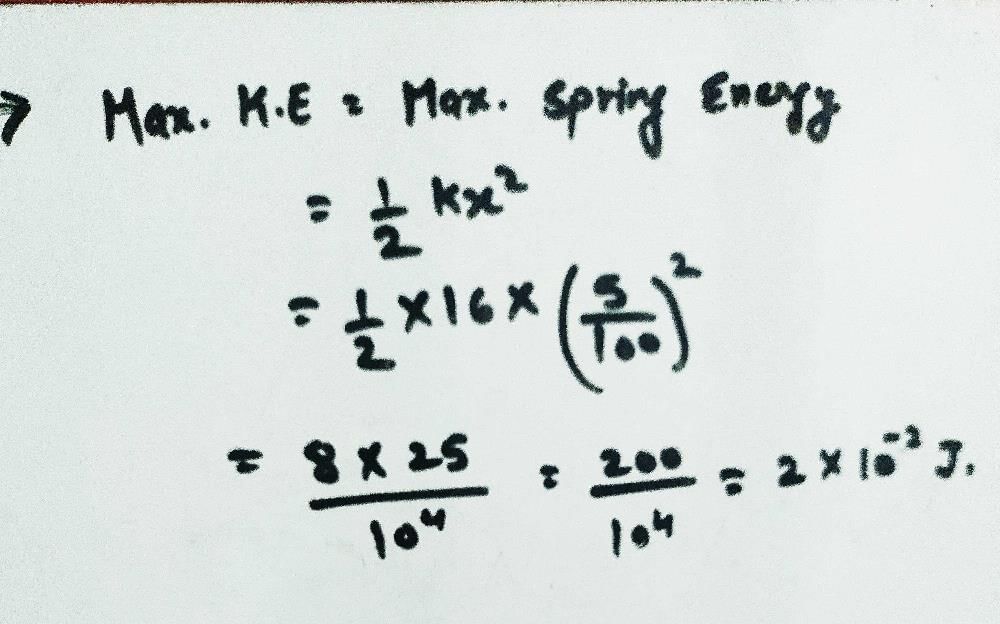
The IUPAC name of the compound having the molecular formula Cl₃C-CH₂CHO is- a)3,3,3-Trichloropropanal
- b)1,1,1-Trichloropropanal
- c)2,2,2-Trichloropropanal
- d)Chloral
Correct answer is option 'A'. Can you explain this answer?
a)
3,3,3-Trichloropropanal
b)
1,1,1-Trichloropropanal
c)
2,2,2-Trichloropropanal
d)
Chloral
|
|
Sai Nikhil answered |
According to the IUPAC nomenclature we give preference to the functional group so no. should be from right to left at 1st position CHO gp mean aldehyde give 'al'at last position 3C so propanal at 3rd position cl go is present so name is''3,3,3trichloropropanal
Consider the following matched about number of bones-
(1) thoracic vertebrae- 12
(2) floating ribs – 11th and 12th
(3) ankle bones - 8
(4) phalanges - 15
How many are correctly matched-- a)one
- b)two
- c)three
- d)four
Correct answer is option 'B'. Can you explain this answer?
Consider the following matched about number of bones-
(1) thoracic vertebrae- 12
(2) floating ribs – 11th and 12th
(3) ankle bones - 8
(4) phalanges - 15
How many are correctly matched-
(1) thoracic vertebrae- 12
(2) floating ribs – 11th and 12th
(3) ankle bones - 8
(4) phalanges - 15
How many are correctly matched-
a)
one
b)
two
c)
three
d)
four

|
Simran Rajput answered |
Thoracic consists of 12 bones and the bones of last pair (11th and 12th ) are called floating ribs or false bones
1 and 2 options are right.
options 3 and 4 are wrong because phalanges are 14 and ankle bones are 7
suming up all answer is 'b'
Mitosis can be studied in- a)Onion root tip
- b)Garlic root tip
- c)Tendril tip
- d)All the above
Correct answer is option 'D'. Can you explain this answer?
a)
Onion root tip
b)
Garlic root tip
c)
Tendril tip
d)
All the above
|
|
Priya Menon answered |
► Cell division is the basic requirement for the growth and development of the body, if the cells top dividing the body will eventually die.
There are two types of cell divisions:
- One occurs in the gamete cell and is necessary for reproduction as this cell division leads to genetic material exchange, this is meiosis or the reductional division.
- The other one is mitosis also known as Equational division which occurs in the somatic cells of the body and this cell division is employed in the repair of the body and increasing the number of cells for growth and development.
► In plants, mitosis occurs in the meristems which have the ability to divide continuously.
Meristems in plants are of two types:
- Apical meristems which are present on the tips of roots and shoots and they help in the elongation of length of the plant.
- The other is lateral meristem which helps in increasing the width of the plant.
Plants don’t repair or replace their damaged parts like leaves, branches but for new ones due to the continuous production of new cells in the meristems.
Mitosis in Onion Root Tips:
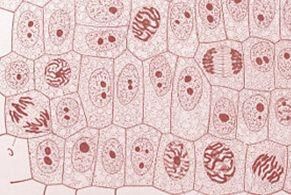
Acetaldehyde and acetylene can not be distinguished by :- a)Tollen’s reagent
- b)Fehling solution
- c)Lucas reagent
- d)Iodoform test
Correct answer is option 'C'. Can you explain this answer?
Acetaldehyde and acetylene can not be distinguished by :
a)
Tollen’s reagent
b)
Fehling solution
c)
Lucas reagent
d)
Iodoform test
|
|
Ananya Das answered |
Lucas reagent can not be used to distinguished Acetaldehyde and acetylene.
Three resistors each of 2 ohm are connected together in a triangular shape. The resistance between any two vertices will be- a) 4/3 ohm
- b) 3/4 ohm
- c) 3 ohm
- d) 6 ohm
Correct answer is option 'A'. Can you explain this answer?
a)
4/3 ohm
b)
3/4 ohm
c)
3 ohm
d)
6 ohm
|
|
Aman Choudhary answered |
Explanation:
When three resistors each of 2 ohm are connected together in a triangular shape, the resistance between any two vertices can be found using the following steps:
Step 1: Calculate the equivalent resistance of two resistors in series.
When two resistors are connected in series, their resistances add up. Therefore, the equivalent resistance of two 2 ohm resistors in series is:
R1 + R2 = 2 ohm + 2 ohm = 4 ohm
Step 2: Calculate the equivalent resistance of two resistors in parallel.
When two resistors are connected in parallel, their equivalent resistance can be calculated using the following formula:
1/Req = 1/R1 + 1/R2
where Req is the equivalent resistance, R1 and R2 are the resistances of the two resistors.
Therefore, the equivalent resistance of two 4 ohm resistors in parallel is:
1/Req = 1/4 + 1/4 = 1/2
Req = 2 ohm
Step 3: Calculate the equivalent resistance of three resistors in a triangular shape.
When three resistors are connected in a triangular shape, their equivalent resistance can be calculated using the following formula:
Req = R1 + R2 + R3 + 2(R1R2 + R2R3 + R3R1)^(1/2)
where R1, R2, and R3 are the resistances of the three resistors.
Therefore, the equivalent resistance of three 2 ohm resistors in a triangular shape is:
Req = 2 ohm + 2 ohm + 2 ohm + 2(2 ohm x 2 ohm + 2 ohm x 2 ohm + 2 ohm x 2 ohm)^(1/2)
Req = 6 ohm
Step 4: Calculate the resistance between any two vertices.
The resistance between any two vertices of the triangular shape is equal to the equivalent resistance of the two resistors that are not connected to those vertices.
Therefore, the resistance between any two vertices of the triangular shape is:
Req/2 = 6 ohm/2 = 3 ohm
Hence, the correct option is (a) 4/3 ohm.
When three resistors each of 2 ohm are connected together in a triangular shape, the resistance between any two vertices can be found using the following steps:
Step 1: Calculate the equivalent resistance of two resistors in series.
When two resistors are connected in series, their resistances add up. Therefore, the equivalent resistance of two 2 ohm resistors in series is:
R1 + R2 = 2 ohm + 2 ohm = 4 ohm
Step 2: Calculate the equivalent resistance of two resistors in parallel.
When two resistors are connected in parallel, their equivalent resistance can be calculated using the following formula:
1/Req = 1/R1 + 1/R2
where Req is the equivalent resistance, R1 and R2 are the resistances of the two resistors.
Therefore, the equivalent resistance of two 4 ohm resistors in parallel is:
1/Req = 1/4 + 1/4 = 1/2
Req = 2 ohm
Step 3: Calculate the equivalent resistance of three resistors in a triangular shape.
When three resistors are connected in a triangular shape, their equivalent resistance can be calculated using the following formula:
Req = R1 + R2 + R3 + 2(R1R2 + R2R3 + R3R1)^(1/2)
where R1, R2, and R3 are the resistances of the three resistors.
Therefore, the equivalent resistance of three 2 ohm resistors in a triangular shape is:
Req = 2 ohm + 2 ohm + 2 ohm + 2(2 ohm x 2 ohm + 2 ohm x 2 ohm + 2 ohm x 2 ohm)^(1/2)
Req = 6 ohm
Step 4: Calculate the resistance between any two vertices.
The resistance between any two vertices of the triangular shape is equal to the equivalent resistance of the two resistors that are not connected to those vertices.
Therefore, the resistance between any two vertices of the triangular shape is:
Req/2 = 6 ohm/2 = 3 ohm
Hence, the correct option is (a) 4/3 ohm.
Chapter doubts & questions for NEET Mock Test Series - Updated 2026 Pattern - NEET Mock Test Series - Updated 2026 Pattern 2025 is part of NEET exam preparation. The chapters have been prepared according to the NEET exam syllabus. The Chapter doubts & questions, notes, tests & MCQs are made for NEET 2025 Exam. Find important definitions, questions, notes, meanings, examples, exercises, MCQs and online tests here.
Chapter doubts & questions of NEET Mock Test Series - Updated 2026 Pattern - NEET Mock Test Series - Updated 2026 Pattern in English & Hindi are available as part of NEET exam.
Download more important topics, notes, lectures and mock test series for NEET Exam by signing up for free.

Contact Support
Our team is online on weekdays between 10 AM - 7 PM
Typical reply within 3 hours
|
Free Exam Preparation
at your Fingertips!
Access Free Study Material - Test Series, Structured Courses, Free Videos & Study Notes and Prepare for Your Exam With Ease

 Join the 10M+ students on EduRev
Join the 10M+ students on EduRev
|

|
Create your account for free
OR
Forgot Password
OR
Signup to see your scores
go up
within 7 days!
within 7 days!
Takes less than 10 seconds to signup

